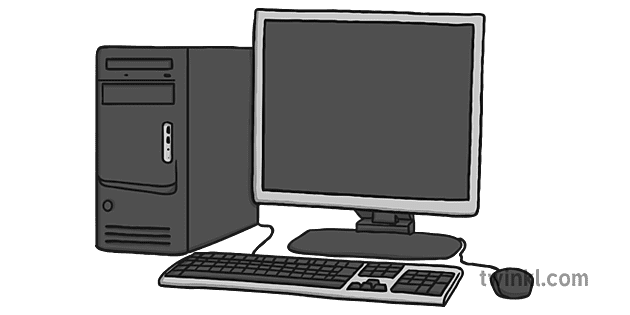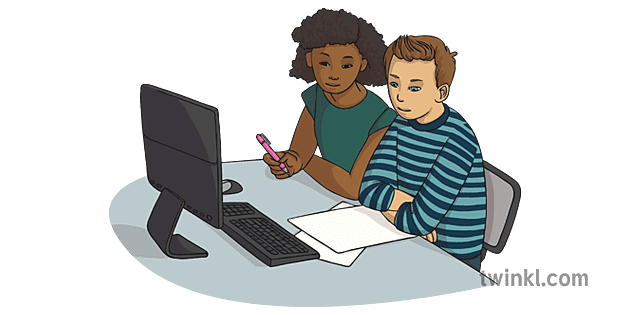


Most likely, you’ve used a computer or tablet today. Perhaps you’ve used one to look something up, send a message to a friend, or watch a funny video. You’re also using a computer right now to read this amazing wiki! Computers have transformed our world and our lives, and never before have we had so much information available to us - and just at the touch of a button. But, have you ever asked yourself, what is a computer?
If you want to find out more about computers, such as when they were invented and what useful things they can do, then read this wonderful teaching wiki! This wiki, also includes recommendations to our incredible computing and IT resources you can use with your pupils, so they can learn more about computers.
When answering the question ‘what is a computer?’ it’s important to consider where the name ‘computer’ comes from. The word computer actually comes from the Latin word ‘computare’ which means ‘to calculate’ or ‘to count’. As computers weren’t around in the Roman era, the name ‘computer’ was given to people who did calculations using mechanical calculators, such as the abacus. In 1613, English poet Richard Braithwaite also used the term ‘computer’ to describe someone who could do calculations perfectly.
Today, a computer refers to an electronic device that can input, output, store and process information, otherwise known as ‘data’. The computer receives data in a combination of 1s and 0s, known as binary code. You can think of binary code as its own language, that computers translate into complex things, such as an image or a video.
To be able to translate this code, and work, computers need programming. Computer programming involves writing a list of instructions for the computer to follow. For example, if you were to click here, which is a link to our computing curriculum for KS2, your computer will know to send you to the right web page because someone has programmed it to follow that instruction.
Coincidentally, programming is one of the units of work children will do in Year 3 computing and IT lessons. This wonderful, teacher-made Computing: Programming Turtle Logo and Scratch Year 3 Unit Pack includes everything you need to teach your children how to create and debug algorithms that accomplish specific goals and complete demands.
Computers are made up of both hardware and software. Hardware refers to the physical parts of a computer, both external and internal, such as a keyboard or a computer circuit board. Software refers to the instructions this hardware is given, as explained above.

When talking about computers, most people are referring to ‘personal computers’, such as laptops or desktop computers. And, our smartphones have now become small personal computers we use throughout the day. But, did you know that there are different types of computer? Yes, different computers have different data processing abilities, and they are categorised based on their purpose, data handling and functionality.
The different types of computers are:
Analogue computers process analogue data and store their data in a continuous form of physical quantities. They perform calculations (rather than instructions) with the support of measures. They’re great for situations where data needs to be measured directly.
A workstation is a special type of computer that is connected to a network, and the operating systems they use allow more than one person to work on it at the same time. They are mainly used for scientific applications.
A minicomputer is… well a mini computer. It has most of the features of a personal computer and is capable of doing the same things, but it’s physically smaller.
A mainframe computer is a large and powerful computer that can do large information processing jobs, such as managing all the data for large organisations. These are used by the government for census or by big companies to analyse consumer statistics.
A supercomputer is not only the most expensive type of computer there is, it’s also the most powerful computer. It has great memory and speed - it’s said to be nearly a thousand times faster than a personal computer, and they are able to perform billions of calculations per second.
So, when answering the question ‘what is a computer?’ you’ll now be able to explain that there are different types of computers and whilst they all perform the same functions, they have different capabilities.
We can’t answer ‘what is a computer?’ without also looking at the history of computers. So, let’s begin!
The first mechanical computer was built by Charles Babbage in 1837. Charles Babbage, was a mathematician, inventor, mechanical engineer and philosopher, and is thought to be the ‘Father of the Computer’ because his Analytical Engine could input and output data. The input of data was done via punched cards, these controlled the mechanical calculator.
However, Charles Babbage only considered his invention to be a sophisticated calculating machine, it was Ada Lovelace who recognised it could do more than calculations.
Ada Lovelace, a mathematician, was intrigued by the Analytical Engine and worked out that it could do many sorts of processes, such as compose music. In 1847, she came up an algorithm that instructed the machine to perform different functions. So, Ada Lovelace is considered to be the first computer programmer.
Alan Turing is one of the most influential people of the 20th century. During his time at Princeton University, Turing designed a theoretical machine, which he named the Universal Machine, that could solve any mathematical problem and perform any task.
Alan Turing was more than just a theorist, though. He worked as a codebreaker during the Second World War, and attempted to decode the German military’s Enigma Cipher machine. The encryptions the Enigma Cipher machine created were impossible to decode, and there were billions of encryption schemes.
This led Turing, along with the help of his colleagues and the work of Polish mathematicians, to devise an electromechanical machine that could scan through all the encryptions and help the Allied Intelligence decode the Germans’ Enigma Code. This electromechanical machine, called Bombe, shortened the Second World War by two years, saving millions of live, and was the beginning of digital computers as we know them today.

After the Second World War, Alan Turing continued his work and was employed by the National Physical Laboratory. There, he designed the Automatic Computing Engine (the ACE) which was the first electronic stored-programme all-purpose digital computer.
If you want to teach your children about Alan Turning and his amazing accomplishments, then download this informative, and beautifully-illustrated KS2 Alan Turing and Enigma PowerPoint. Your children will learn all about Alan Turing and his contributions to the computer.
Many advancements were made to improve and develop the computer in the 20th century, but one notable advancement was the founding of Microsoft. Bill Gates and Paul Allen founded Microsoft in 1975, and they developed an operating system in partnership with IBM. A year later Steve Jobs, Steve Wozniak and Ronald Wayne founded Apple INC and created Apple 1 which was the first computer with a single circuit board.

In 1981, IBM released the first personal computer, which used Microsoft’s operating system. This led to the development of many personal computers which included a display, a printer, disk drives, extra memory and a game adaptor.
The invention of the internet began in 1983, and computer scientists Vinton Cerf and Bob Kahn worked on inventing the Internet communications protocols we use today. The internet is a large network of connected computers, where users can communicate to each other and share information.
It wasn’t until the invention of the World Wide Web, by Sir Tim Berners-Lee in 1989, though, that the internet was accessible to everyone - not just scientists. The World Wide Web (or www) allows web pages to be found easily on this network of computers. The internet allows you to access and read these pages on your screen, from the comfort of your living room or whilst travelling on a train.
To help your pupils learn and understand the difference between the two, have a look at this wonderful The Difference Between the Internet and the World Wide Web PowerPoint. And, if you are teaching them the history of computing, you can download and print off this fantastic History of Computing Display Timeline. You can also watch this fantastic video to learn more!
These are just a few examples of how a computer is used to today and how computers have helped us and bettered our lives. It is important, though, to be aware of how to use computers, particularly the internet, safely.
Every February schools in the UK celebrate Safer Internet Day! It's an opportunity for children to learn about the threats they may face online, what kind of information they should never share on the Internet and consider their own actions when talking to others on chat sites or social networks.
To get involved, have a read of our blog, 'Safer Internet Day Activities and Ideas to Protect your Class Online'.
If you’re teaching young children, use this Computing: Online Safety: Year 1 Unit Pack to introduce the topic of online safety. For older children, you can use our Computing: Online Safety Year 4 Unit Pack:
Hopefully this teaching wiki has answered the question ‘what is a computer’ and you now know more about the device you use everyday! For more resources, activities and lesson materials that will help you teach your children computing skills and IT, browse through our primary computing scheme of work.

If you enjoyed reading this 'What is a Computer?' Teaching Wiki, you might like to check out more of our pages:
What is the National Curriculum for Computing?